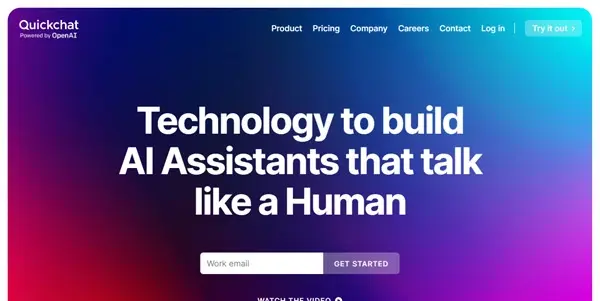Quickchat AI

A site that allows you to easily create AI assistants with GPT-3. Integration with the help of APIs
Quickchat AI: Building AI Assistants Made Easy
Quickchat AI is a powerful yet accessible platform that empowers developers and non-developers alike to create custom AI assistants leveraging the capabilities of GPT-3. By simplifying the integration process through APIs and offering a no-code/low-code approach, Quickchat AI significantly lowers the barrier to entry for building sophisticated AI applications. This article delves into its functionalities, benefits, applications, and how it stacks up against competitors.
What Quickchat AI Does
Quickchat AI streamlines the process of developing AI assistants. Instead of wrestling with complex GPT-3 APIs and intricate coding, users can leverage Quickchat AI's intuitive interface to design, build, and deploy their own intelligent assistants. This allows for rapid prototyping and iteration, speeding up the development lifecycle considerably. The platform handles the heavy lifting of API integration, leaving users to focus on the core functionality and desired user experience of their AI assistant.
Main Features and Benefits
- Simplified GPT-3 Integration: Quickchat AI abstracts away the complexities of GPT-3 API interactions. Users don't need deep expertise in coding or API management.
- No-Code/Low-Code Approach: The platform provides a user-friendly interface, minimizing the need for extensive programming knowledge. Even users with limited coding experience can build functional AI assistants.
- Customizable Assistants: Create AI assistants tailored to specific needs and applications, from simple chatbots to complex conversational agents.
- Rapid Prototyping: Quickly build and test different AI assistant designs, enabling rapid iteration and refinement.
- Scalability: Built for scalability, allowing you to handle increasing user demands as your AI assistant grows in popularity.
- API Access: While offering a no-code interface, Quickchat AI also provides API access for advanced users who prefer a programmatic approach.
Use Cases and Applications
The versatility of Quickchat AI makes it suitable for a wide range of applications:
- Customer Service Chatbots: Automate customer support interactions, handling frequently asked questions and routing complex inquiries to human agents.
- Internal Knowledge Bases: Create AI-powered assistants to access internal documents, policies, and knowledge bases efficiently.
- Personalized Learning Assistants: Develop AI tutors or assistants that cater to individual learning styles and provide personalized feedback.
- Interactive Storytelling: Build engaging narrative experiences with AI-driven characters and dynamic storylines.
- Automated Task Management: Create assistants that help manage tasks, schedule appointments, and send reminders.
Comparison to Similar Tools
Several platforms offer GPT-3 integration, but Quickchat AI differentiates itself through its focus on ease of use and a streamlined development process. While competitors may offer more advanced features for experienced developers, Quickchat AI prioritizes accessibility for a broader audience. It's a strong choice for users prioritizing rapid development and ease of implementation over highly specialized features. A direct comparison would require analysis of specific competitors' features and pricing, but Quickchat AI's strength lies in its user-friendly interface and no-code/low-code approach.
Pricing Information
Quickchat AI operates on a paid subscription model. Specific pricing details, including tiers and features included in each tier, are available on the Quickchat AI website. It's recommended to visit their pricing page for the most up-to-date information.
Conclusion
Quickchat AI is a valuable tool for anyone looking to leverage the power of GPT-3 to build AI assistants without the need for extensive coding expertise. Its user-friendly interface, simplified integration, and focus on rapid prototyping make it an attractive option for developers and non-developers alike. The range of applications is broad, making it a versatile asset for businesses and individuals seeking to enhance their workflows and user experiences with AI.